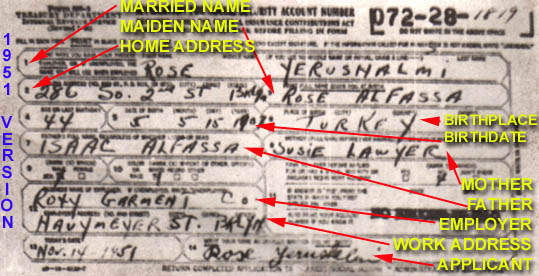United States Social Security Application
Form SS-5: A Useful Genealogical Resource
by S. Alfassa / 2001
Introduction
The Social Security system in the United States was established during the Great Depression of the 1930s as a safety net for Americans during their old age. Signed into law 14 Aug 1935, the Social Security Act (R.R. 7260, Public Law No. 271, 74th Congress), workers had a source of income when they were too old to continue working. Significant changes have occurred over the decades since this federally mandated old-age income went into effect, and American workers don't expect much "security" from this source, but the program has helped many life a descent life after their working career is over.
How does this help me?
The application form used by people to enroll for Social Security is a valuable resource for Sepahrdic genealogists. All of the application forms have been archived by the U.S. governement, and are stored away on microfilm. A copy of which is available to you for a small fee of $7.00. First, find your ancestor on the Social Security Death Index (SSDI) to obtain their Social Security number, with it you can request a copy of your ancestor's application form.

Fig 1. The 1951 version of a Social Security application. The misspelling of the Sephardic name "Loya" for "Lawyer" (as used in the document) is discussed in the text. (Source: Alfassa/Benson/Yerushalmi family)
The application form is a good source of genealogical information. You will find an ancestor's birthdate, birthplace, father's name, mother's name, and more. What if you already know this information? There are other reasons to order a copy of the SS-5. For instance, since the information was provided by your ancestor and not a secondary party, the SS-5 is good supporting documentation for corroborating previous research. Also, you may find that the SS-5 does not corroborate what you already know to be "fact". The SS-5 can also be a source of unexpected information. Figure 1. and 2. on this page represent two SS-5 forms from two sisters of the same family. Notice in Figure 1. the surname "LAWYER". This is not obviously a Sephardic name, but when the SS-5 of the sister from the same family was examined, it became clear that the name was really "LOYA" (an old Spanish name). This corresponds with other documents later supporting this conclusion.
If the person you're searching for was alive and working sometime from 1937 on, there's a good chance there's an application on file for him (unfortunately, this is a less useful resource for women until recent decades when virtually everyone started to get a Social Security card). What makes the Social Security application so valuable is that the names of the parents were provided by the very person being researched! In addition, the Sephardic Genealogist obtains a treasured copy of the applicant's signature!
 Fig 2. The 1972 Version of a Social Security Application. Note the removal of the employer information. (Source: Alfassa/Benson/Yerushalmi family)
Fig 2. The 1972 Version of a Social Security Application. Note the removal of the employer information. (Source: Alfassa/Benson/Yerushalmi family)
The format of the Social Security Number Application (SS-5) changed from year to year (see Fig. 1 - 3), but should contain the following:
- Applicant's first, middle and last names
- For women, the maiden name or previous married name
- Applicant's address
It may also included:

